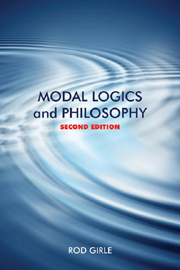Book contents
- Frontmatter
- Contents
- Preface
- Acknowledgements
- 1 Argument and modality
- Part 1 Formal systems
- 2 A simple modal logic
- 3 The normal modal logics
- 4 The non-normal modal logics
- 5 Natural deduction and axiomatics
- 6 Conditional logic
- 7 Modal predicate logics
- 8 Quantifiers and existence
- Part 2 Applications
- Answers
- Index
4 - The non-normal modal logics
from Part 1 - Formal systems
- Frontmatter
- Contents
- Preface
- Acknowledgements
- 1 Argument and modality
- Part 1 Formal systems
- 2 A simple modal logic
- 3 The normal modal logics
- 4 The non-normal modal logics
- 5 Natural deduction and axiomatics
- 6 Conditional logic
- 7 Modal predicate logics
- 8 Quantifiers and existence
- Part 2 Applications
- Answers
- Index
Summary
Introduction
Two of the normal modal logics are S4 and S5. These logics were created by C. I. Lewis (1883–1964) as part of a sequence of modal logics. The logics started with System 1, S1, and go on to S2, S3, S4, and S5. The first three of these are not normal modal logics, and are referred to as either non-normal or sub-normal. We shall use the term “non-normal” to refer to them, and to other such logics.
There are various ways in which the distinction between the normal and the non-normal logics can be described or defined. Some descriptions focus on the differences between the sets of valid formulas. Some focus on differences in the logic apparatus. In our case we shall focus on systematic differences in the tree rules.
The tree rules we have given so far are rules that apply to formulas in all worlds. The definition of validity applies across all worlds. In non-normal logics we depart from this uniformity. We need different modal rules depending on the world the formula is in. The definition of validity is also qualified.
Two sorts of worlds
In any tree for modal logic the tree begins at some arbitrary world. We have always begun with n. This world can be any world in a system of worlds for a normal modal logic. But, in the non-normal modal logics the worlds are divided into two sets.
- Type
- Chapter
- Information
- Modal Logics and Philosophy , pp. 52 - 67Publisher: Acumen PublishingPrint publication year: 2009



